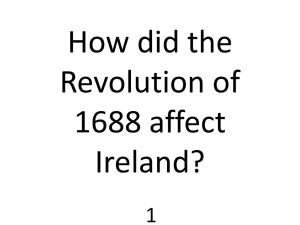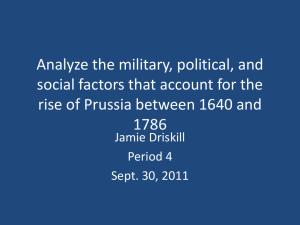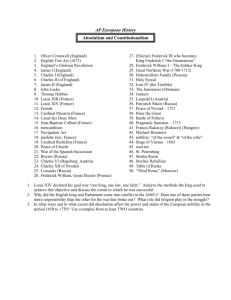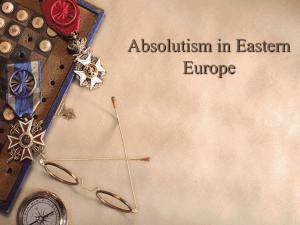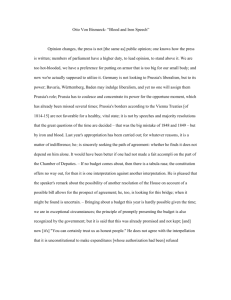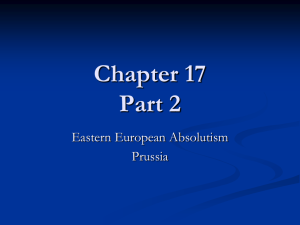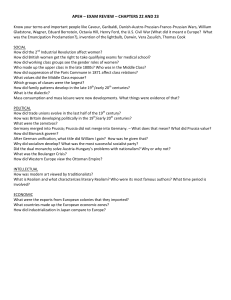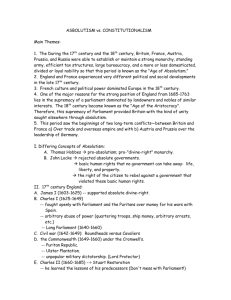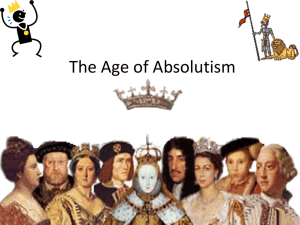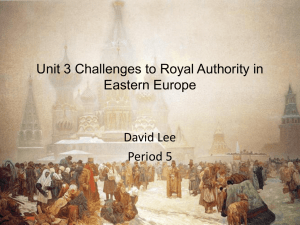Absolutism-UnitOutline
advertisement
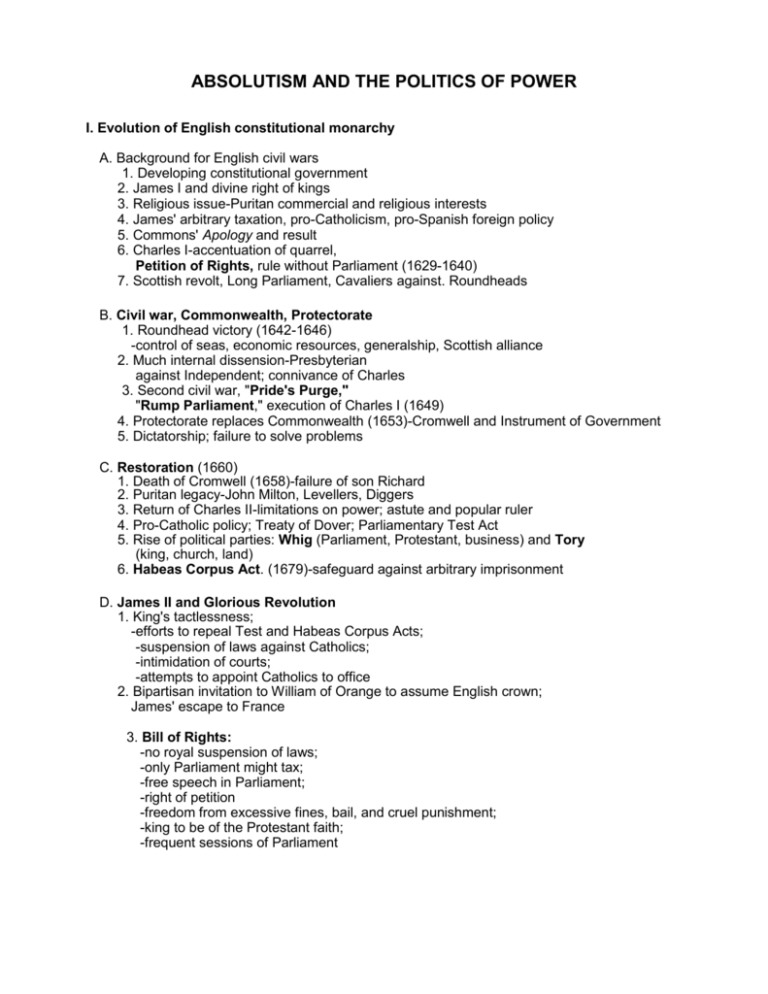
ABSOLUTISM AND THE POLITICS OF POWER I. Evolution of English constitutional monarchy A. Background for English civil wars 1. Developing constitutional government 2. James I and divine right of kings 3. Religious issue-Puritan commercial and religious interests 4. James' arbitrary taxation, pro-Catholicism, pro-Spanish foreign policy 5. Commons' Apology and result 6. Charles I-accentuation of quarrel, Petition of Rights, rule without Parliament (1629-1640) 7. Scottish revolt, Long Parliament, Cavaliers against. Roundheads B. Civil war, Commonwealth, Protectorate 1. Roundhead victory (1642-1646) -control of seas, economic resources, generalship, Scottish alliance 2. Much internal dissension-Presbyterian against Independent; connivance of Charles 3. Second civil war, "Pride's Purge," "Rump Parliament," execution of Charles I (1649) 4. Protectorate replaces Commonwealth (1653)-Cromwell and Instrument of Government 5. Dictatorship; failure to solve problems C. Restoration (1660) 1. Death of Cromwell (1658)-failure of son Richard 2. Puritan legacy-John Milton, Levellers, Diggers 3. Return of Charles II-limitations on power; astute and popular ruler 4. Pro-Catholic policy; Treaty of Dover; Parliamentary Test Act 5. Rise of political parties: Whig (Parliament, Protestant, business) and Tory (king, church, land) 6. Habeas Corpus Act. (1679)-safeguard against arbitrary imprisonment D. James II and Glorious Revolution 1. King's tactlessness; -efforts to repeal Test and Habeas Corpus Acts; -suspension of laws against Catholics; -intimidation of courts; -attempts to appoint Catholics to office 2. Bipartisan invitation to William of Orange to assume English crown; James' escape to France 3. Bill of Rights: -no royal suspension of laws; -only Parliament might tax; -free speech in Parliament; -right of petition -freedom from excessive fines, bail, and cruel punishment; -king to be of the Protestant faith; -frequent sessions of Parliament E. Results of Glorious Revolution 1. Divine right discredited-dominance of Parliament 2. Shift away from pro-French policy- increasing English participation in international affairs 3. Toleration Act (1689); -increased freedom of press; -more independent judiciary; -Parliamentary consent for large army in peacetime 4. Limited nature of Glorious Revolution -control by wealthy merchants and gentry F. Cabinet government 1. William III and King's Council; -use of ministers from one party; -development of policy-making cabinet under Anne 2. George I and George II -Robert Walpole as first prime minister (1721-1742) 3. Cabinet as administrative agency of House majority -must resign when Commons rejects policies 4. Pitt the Elder and the pretensions of George II-"King's Friends" and decline of Whigs 5. Lord North, Tory majority, and George III in control (1770-1782) 6. American Revolution; -discrediting of North; -Pitt the Younger rescues cabinet system 7. New Tory party-Aristocratic Liberalism continues II. The rise of Russia A. Background of isolation and backwardness -hopes of expansion and progress B. Peter the Great (1682-1725) 1. Objectives: to Europeanize Russia, obtain outlet, make tsar's power absolute 2. Methods: -war with Turkey and Sweden; -social and economic reforms; -subjection of nobility and Church 3. Achievements: -elimination of Swedish dominance in Baltic; -firm establishment of absolutism in Russia C. Catherine the Great 1. Brilliant, unscrupulous, immoral 2. Gains on Black Sea and in Poland D. No solution to problem of Russia's destiny -eastern/western or combination? III. Emergence of Prussia A. Ingredients: -Brandenburg, East Prussia, Cleves, Mark lands on lower Rhine B. Rise of House of Hohenzollern 1. Frederick becomes elector of Brandenburg (15th century) 2. Elector seizes Catholic wealth, heads Lutheran Church in Brandenburg (16th century) 3. Acquisition of East Prussia, Cleves, Mark, and Ravensberg (17th century) C. Frederick William, the Great Elector (1640-1688) 1. Astute maneuvering in Thirty Years' War builds strength and recognition 2. Gains full sovereignty over East Prussia in Polish-Swedish conflict 3. Encourages industrious emigrants; fosters sea power, commerce, colonization D. Frederick, "King in Prussia" (1688-1713) 1. Wartime assistance to emperor in return for king's title (1701) 2. Treaty of Utrecht extends recognition E. Frederick William I (1713-1740) 1. Military state and efficient civil service 2. Trains son (Frederick the Great) for ruling powerful state IV. Dynastic war and the duel for World Empire A. Independent states and aggressive monarchs -competition: power, riches, glory B. Pattern of strong and weak nations 1. Aggressive powers: France, England, Russia, Prussia 2. Declining powers -Sweden, Holland, Spain, Ottoman Empire, Poland 3. Temptation to aggressors: -Hapsburgs' Holy Roman Empire -with its loose collection of more than two hundred states C. France threatens balance of power 1. Louis XIV seeks "natural boundaries" -invasion of Netherlands, war with Holland, -seizure of Rhine districts 2. War of League of Augsburg 3. War of Spanish Succession -France against coalition (1702-1713) D. Treaty of Utrecht (1713)-balance of power maintained 1. Louis' grandson king of Spain; -prohibit union of French and Spanish thrones 2. France holds modest gains to make -frontiers more defensible 3. Spanish empire divided-Austria obtains Naples, Milan, Sardinia, Spanish-Netherlands. 4. England gains Nova Scotia, Newfoundland, Hudson Bay territory, and Mediterranean naval bases 5. Southern frontier fortresses restored to Dutch 6. Duke of Savoy becomes king and gains Sicily 7. Brandenburg elector recognized as. "King in Prussia" E. Consequences of Louis' wars 1. French sacrifices and discontent 2. Eventual discrediting of absolutism 3. Evolution of balance of power principle 4. Wars become worldwide. F. European colonial rivalries 1. Race for commerce, raw materials, territory -profitable colonies, the key to economic progress 2. England against France in North America, -West Indies, India, West African coast 3. Colonial success affects European balance of power G. Wars of Jenkins' Ear and Austrian Succession-dynastic struggle continued 1. Initially a localized Anglo-Spanish conflict in West Indies (1739-1742) 2. Enlargement by Prussian attack on Austrian Silesia (1740) -involves most of Europe and possessions overseas 3. Peace of Aix-la-Chapelle (1748) "peace without victory" -but Frederick keeps Silesia H. Diplomatic revolution and Seven Years' War (1756-1763) 1. France trades Prussia for Austria; -England trades Austria for Prussia 2. Frederick's early successes in Europe -later perseverance 3. Pitt's "system" -mastery of the seas, -subsidies to Prussia, -English military forces to the colonies 4. Treaty of Paris (1763) -English gains in North America, India, West Indies, West Africa 5. Stage set for American and French Revolutions I. Three Polish partitions (1772, 1793, 1795)
